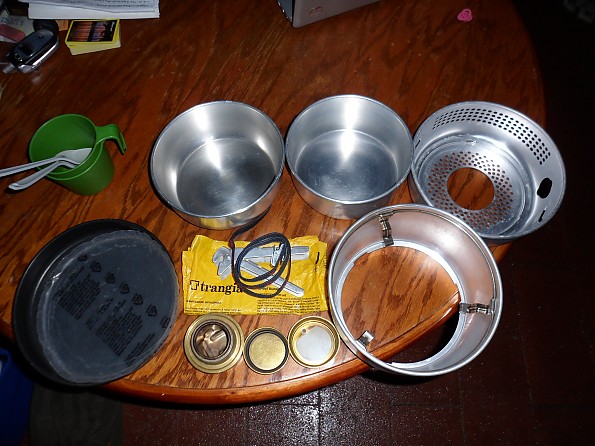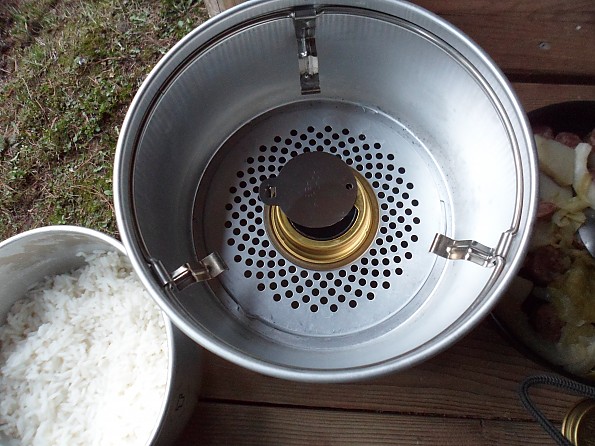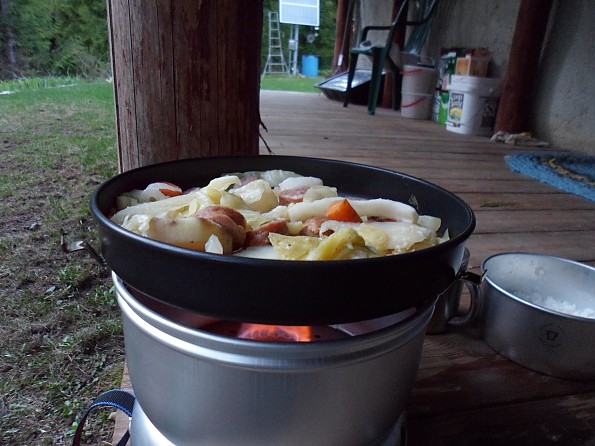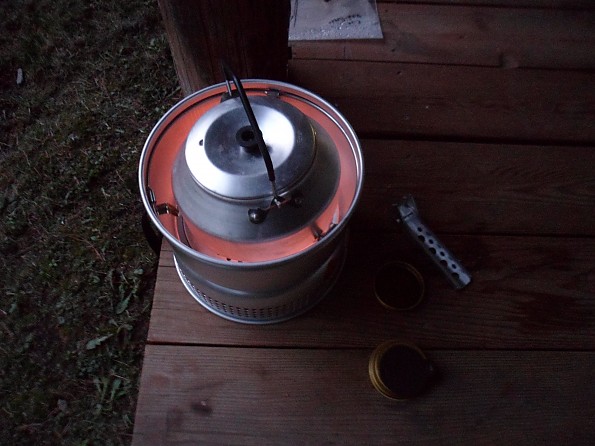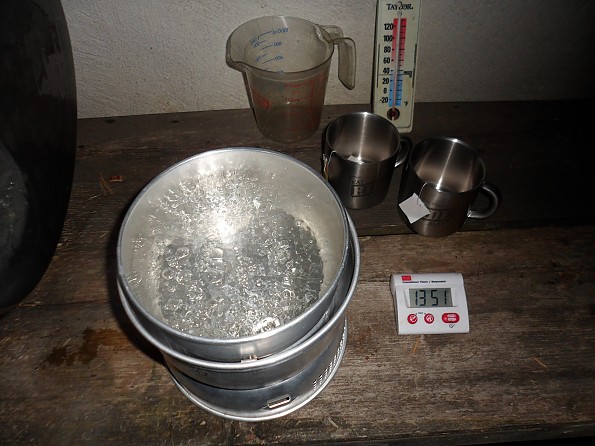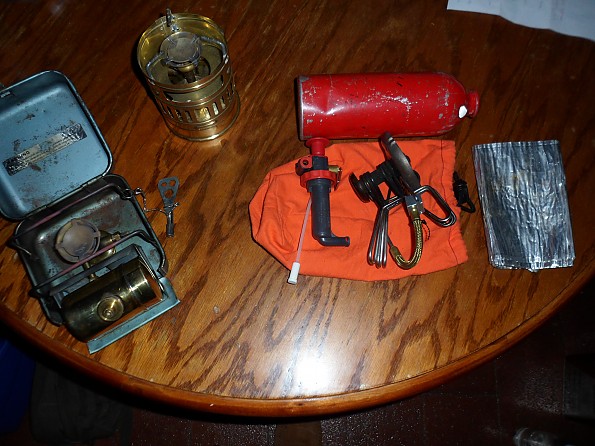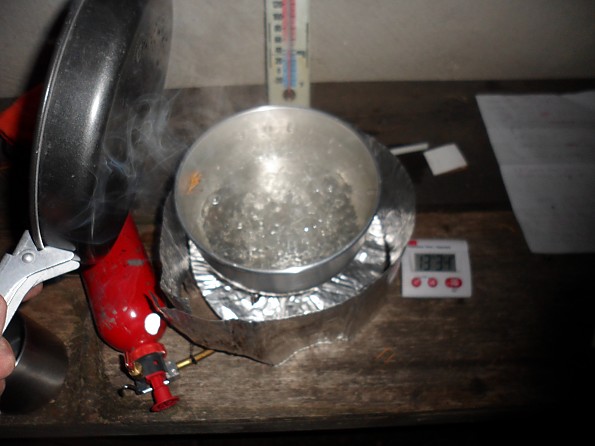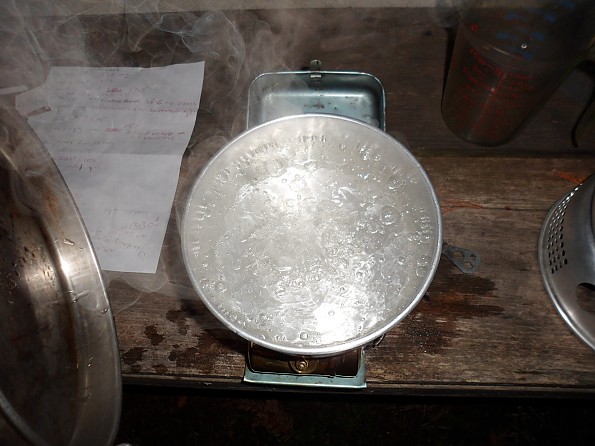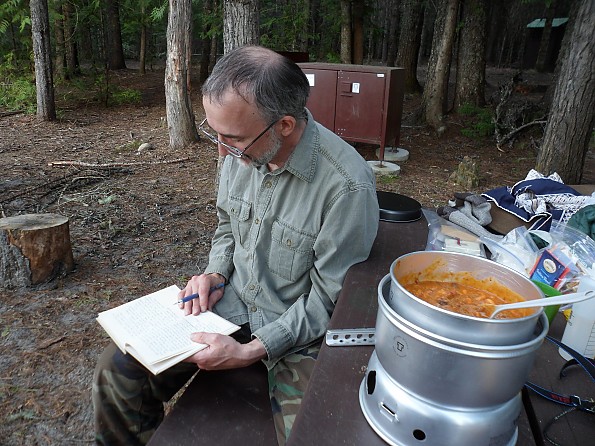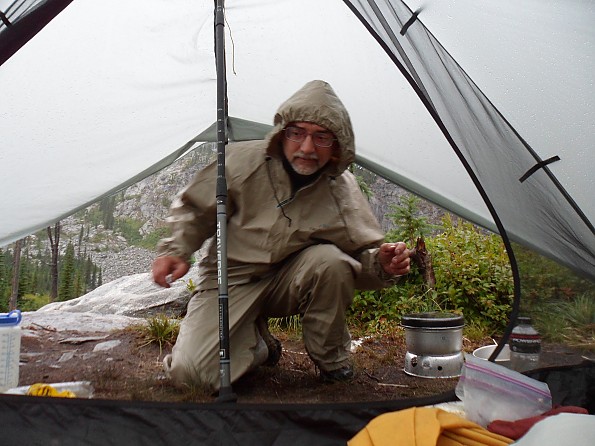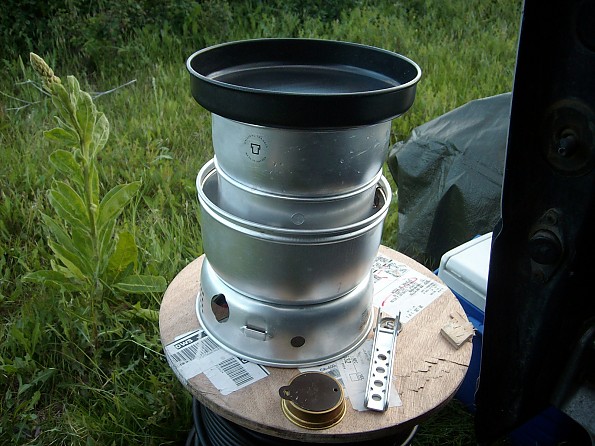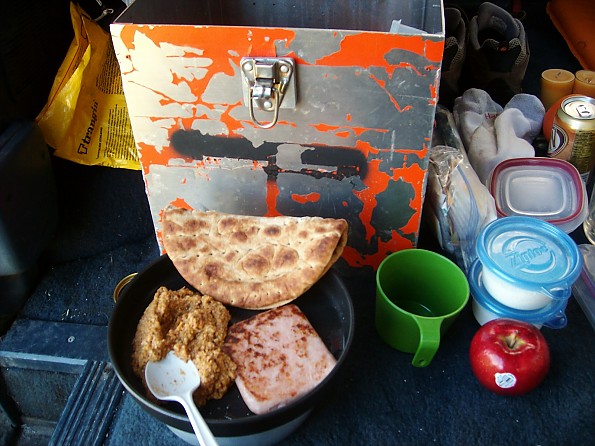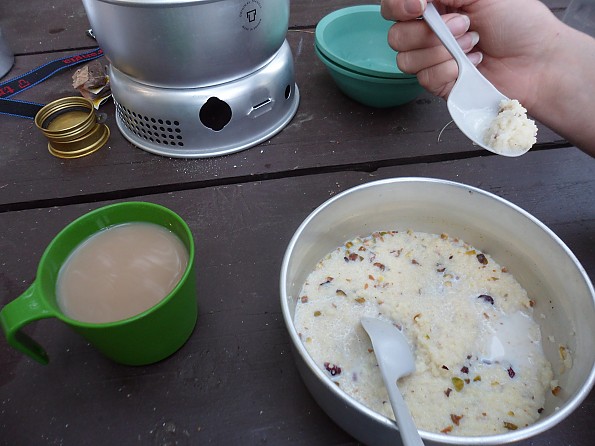Trangia 27-3 UL

To summarize, this is a great stove if you like simple and ultra-reliable things, like to eat well no matter the weather, and maybe don’t mind a little extra weight of stove and fuel.
The Swedish made Trangia 27-3 “ultralight” is a true classic and one of the very best cook kits on the market.
This kit consists of the wonderful brass Trangia alcohol burner with simmer and storage caps, an elaborate two part stand / windscreen, two decent sized lightweight aluminum pots, a non-stick aluminum frying pan, an aluminum pot gripper, a thin plastic disc intended to prevent abrasion of the non-stick surface of the fry pan when packed, a nylon strap with metal buckle to hold everything together when packed for travel and a yellow plastic bag intended to wrap the brass burner when packed up inside the kit, thus preventing rattle and the corrosion caused by the contact of dissimilar metals when stored for long periods of time.
The bright yellow bag is also printed with operating instructions in ten different languages and is quite fascinating to try and puzzle out, Rosetta Stone fashion, when stuck in a tent in stormy weather waiting for tea to boil.
What you get, excepting the cups and spoons!
I started messing about with homemade alcohol stoves some time ago and have made quite a variety of them. Pepsi can stoves, Turbo cat, Super cat, Penny stoves, Virtual wick stoves, you name it, I tried it. I hunted the internet for that “perfect” design and spent my free time collecting and cutting up cans. All were fun to make but to my way of thinking they were all little more than ultra-light heaters useful for warming small amounts of water for hikers who cared more about pack weight than about heaping plates of steaming food.
I experimented winter and summer and eventually settled on the Pepsi can type as my favorite, especially oversized versions. I found that these stoves could be relied upon to boil a full quart of water relatively speedily, even in the dead of winter. But they were still adversely effected by even the slightest of breezes, were pretty inefficient, and recovering unburned fuel from a stove was a pain.
Now I know a true gram weenie backpacker would only use the exact amount of fuel needed to warm a carefully calibrated amount of water for rehydrating a precisely measured amount of pre-packed food, and will be happy with however warm the water gets and will simply steep his food in a reflectix cozy until sufficiently rehydrated to be consumable.
But that isn’t me at all. I almost always cook for two and sometimes up to five hungry hikers. We like big meals and often cook up “ordinary” foods instead of dehydrated fare. I find this is especially true of cycling trips where one is always buying food at wayside stores and of short overnight trips where we simply raid the kitchen for food before we leave.
I was drawn to the utter simplicity and reliability of alcohol stoves, and I was tired of fiddling with my MSR Wisperlight. Wasn’t there an alcohol stove out there for me?
After much thought I finally purchased the Trangis 27-3. I simply had to give it a try.
As with any new cooking system ( or other new bit of gear ) I at first experimented quite a bit with it at home before I trusted it for trips, then started using the kit on easy weekend trips in good conditions before gaining the trust to take it on more ambitious adventures and using while traveling for work. Thus, last year I basically used it only under good conditions and around the homestead. This year, it has been my main stove.
So how well does it work?
The Trangia burner itself has a good simmer ring and sufficient capacity for long burns. I found that it holds just enough fuel to boil and simmer a cup of rice, fry up sausage, cabbage, potatoes and onions, and just enough fuel left to boil a kettle of tea after dinner.
Normal flame of the Trangia, used to bring rice to a boil -
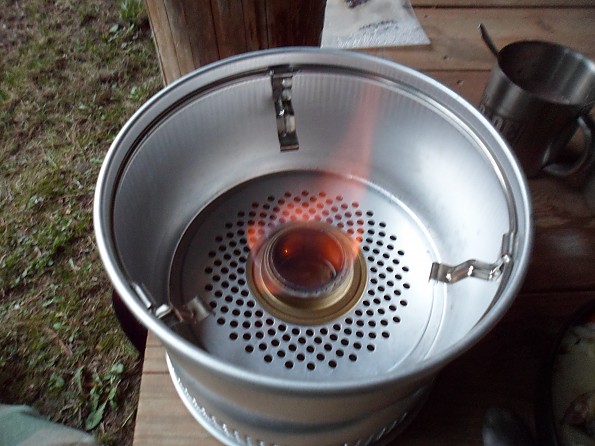
Then to simmer till done the flame is reduced with the simmer ring to almost nothing. In daylight you can't see this flame so you sorta work by feel. This saves a great deal of fuel, and isn't difficult to do. I use the pot gripper to manipulate the simmer ring.
Rice done, the ring comes off for the fry up -
After dinner the stove was relit for tea, and just enough fuel was left to boil the kettle. Sorry, I didn't measure the fuel used, but the Trangia was maybe 2/3s full The kettle holds just under a quart.
Note that this kettle fits inside the kit but is not included in the 27-3!
I have in fact stopped using the kettle because I feel it is just extra weight, the big pot probably boils water a tad faster and if I leave the kettle home I can pack cups and spoons inside the kit.
So, dinner for two from “raw” ingredients on an alcohol stove with only one filling. Pretty durn impressive performance for an alcohol stove. Try that on a Pepsi can or Cat stove!
Sgt Rock calculates that a Trangia burner is about 60% efficient: http://hikinghq.net/sgt_stove/ion_stove.html
That is to say if one milliliter of methyl alcohol has about 17.6 BTUs of energy, a 100% efficient stove would boil a pint of water with just 9 milliliters of alcohol, and in tests a Trangia burner can routinely boil a pint of water with 15 milliliters of fuel ( half an ounce or one table spoon ).
Some designs like the Pepsi can stove will burn hotter and boil water faster at the cost of more fuel, and some stoves are very efficient but will take rather long to boil even a pint of water.
The Trangia is a good compromise. It has more capacity than most all other alcohol stoves, the simmer ring can extend the burn time quite a while and is ideal for simmering or frying, and when done you simply screw on the storage cap and save any remaining fuel. This last feature is unique among alcohol stoves and makes the Trangia burner truly convenient to use.
OK, so it works. Now alcohol stoves in general have a reputation as mighty slow cookers.
Well, lets see about that, shall we?
Last night I measured the time it took to setup the stove, light it and bring a quart of water to a brisk boil.
It took almost 14 minutes. I worked on a bench outside my home. The temp was 39 degrees with a slight breeze blowing. The water from my cistern is 50-something degrees.
Mind you, the stove was packed up when I started. I unpacked it, set it up, opened my fuel bottle and filled the stove, lit it, put the pot on and filled it with a pre-measured amount of water.
Most stove tests are pure fantasy. They use ideal conditions, stoves already setup, lit, and warmed up! That's nonsense. This test was a real measure of how long you will wait from taking the stove out of your pack to full boil of one quart cold water.
And I got almost 14 minutes. Ugh. But is it really that bad? Lets find out.
I can’t compare it to propane/butane stoves because I’ve never owned one. I just can’t get past the throw-away fuel canisters.
Gasoline stoves were my standard for many decades and I own several so I can compare to them. So I broke out all my stoves for a round up!
A trio of perhaps the most used gas stoves of all time, the Svea 123, Optimus 8R and MSR Whisperlight. Surely a simple alcohol stove cannot compare favorably to these tried and true war horses?
First, lets do the real thoroughbred, the MSR Whisperlight!
I got an amazingly slow 13 minutes 30 seconds with the MSR!
What's that you say? It can't be so? Well, lets break it down.
The stove started all packed up in it's stuff sack. I pulled all the parts out, assembled it, attached the fuel bottle, pumped the bottle up twenty times, let a little fuel trickle into the priming cup and lit. This took one and one half minutes. And mind you, there was no fumbling on my part, one of these was my main stove for over twenty years, and I can run one blindfolded!
Priming the stove took another minute and a half, and finally at three minuets time, the pot went on the stove and the wind screen was put around it.
Then I drank my tea, and waited. And waited. At ten minutes time I couldn't believe how long this was taking ( ever watch a pot boil? ) so I pumped the stove five more times. At 12 minutes I pumped the stove up another five times, and it was truly roaring. I had trouble believing it was taking so long, but that's what cold temps will do to any stove. I have tested this very stove under ideal summertime conditions and it can then boil a quart faster than the propane stove in my kitchen, so don't think I have a bum stove in need of a rebuild.
If it makes the MSR fans any happier, remember three of those minutes was assembly and prime time, so actual boil was only ten minutes. Still, this is a realistic test of "grab the stove to hot food" comparison, and the constant fiddle of the MSR is what eventually drove me to alcohol stoves.
Now for a blast from the past, the 8R.
This is not really a fast stove by any means, and I have waited as much as twenty minutes for it to boil a pot in the past. But, it is supposed to be several times more fuel efficient than the MSR, it has very few moving parts, and I simply love the roar and looks I get when I cook over this antique.
It boiled its quart in 16 minutes! Not bad at all, considering setup ( very minimal on this stove ) prime time, and the fact that this stove has no wind screen at all.
Sorry, I didn't do the Svea. It would have been between the MSR and 8R.
So I believe this goes to show that the humble Trangia is for all intents and purposes, is as fast as any stove out there. Or at least as fast as any stove I own.
In practice I find that I cook differently over the Trangia, and that also shortens cook time. Many backpackers routinely use commercial dehydrated foods such as sold by Mountain House. Typically, one blasts the sufficient quantity of water to a boil, pours the heated water into the foil packet the food comes in, and then waits around five or ten minutes for the food to rehydrate. All the while the food cools off, and what hungry hiker has the patience to wait till the food its fully rehydrated? In cold weather in particular the result is often cool, partially rehydrated food.
With my Trangia I find the best way to cook up dehydrated food is to add it into the pot with the cold water, then heat them together.
It isn’t necessary to boil the meal, only cook until it is soft and hot. After the first several minutes the Trangia burner is good and hot the simmer ring can be tossed on to lower the heat to simmer it till done, and save a good bit of fuel in the process.
This method produces hot food just as fast, or actually faster than can be done with the usual setup stove, boil water, add the water and wait method.
Writing in journal while Mountain House chillimac simmers till done.
Cooking this way is also ideal if you’re like me and can’t resist adding stuff to commercial dehydrated foods. We added cubed hard salami and cheddar cheese and a diced tomato to the chili above, greatly improving the taste and nutrition.
Tea can also be made this way, by adding the tea to the cold water and heating to just a simmer. It need not boil, and you’ll actually get to drink it sooner than by boiling water, making tea and letting it steep and cool to a drinkable temp.
It took me a year to adapt to cooking this way, but now I'm hooked on it.
And it is utter simplicity to use, has no prime time, minimal setup, and no worrying about exploding gasoline tanks.
Next we need to consider weight. After all, this is supposed to be for backpacking, right?
The total weight of my Trangia 27-3 is a hefty 31.6 ounces.
The old Optimus 8R is 23.5 ounces empty.
The MSR complete with stuff sack, empty fuel bottle and wind screen, but without the usual spare parts and wrench, is 18.2 ounces.
The empty Svea 123 with stuff sack but without cup or key, is 15.1 ounces.
But the Trangia is not just a stove, it is also an elaborate cook kit as well!
The basic "stove" part of the Trangia setup is the brass burner, cap, simmer ring, upper and lower stand.
Just the "stove" bit -
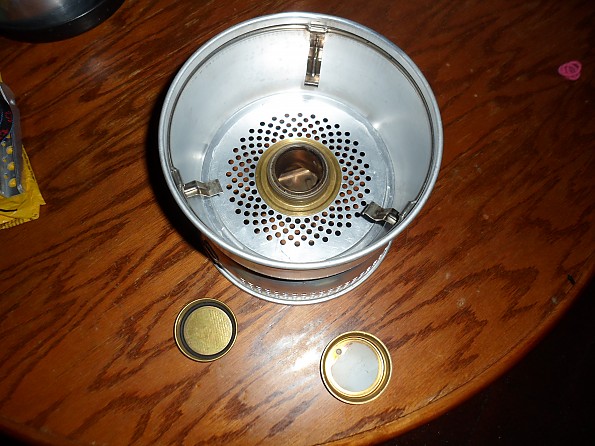
The weight of the above parts is 15.2 ounces, so it compares very well with the gasoline stoves.
The cook kit of fry pan, two pots, and gripper is 15.4 ounces.
The plastic bag and strap add an additional .9 ounce, for a total of 31.6 ounces.
I measured the total weight of the Trangia 27-3 with two plastic spoons and cups stored inside along with a pint plastic soda bottle of alcohol, and got about 3-1/4 pounds. This is my typical load for a three or four day trip with my wife.
Other benefits of the Trangia include its excellent stability, wind resistance and mild manners.
Many other alcohol and some gasoline stoves use foil wind screens. These can be very efficient and lightweight, but in gale force winds they simply blow away. Granted we usually cook in sheltered spots, but sometimes the unexpected happens.
This goofy photo is me cooking breakfast for five on the Trangia 27-3 one very windy and rainy morning at 6,000 feet in the vestibule of my tent.
Uneven ground and high winds don’t begin to faze this stove. It is well encased and all the flame is contained making it safer to use near flammable silnylon tents.
Another interesting feature of this setup is the ability to stack the pans one atop the other
I discovered this while heating two pots of water at once for a sponge bath. –
This summer I spent over two weeks living out of a van on BLM land while working on a project in a nearby town.
I saved a great deal of coin by avoiding motels and used my Trangia for cooking meals and heating wash water during this time. I used up the pint of alcohol I had brought with me and about half a 12 ounce bottle of “Yellow Heat” gas line antifreeze I purchased at a gas station. Not bad for fuel usage I thought. Every evening in camp I cooked dinner, made a pot of tea and heated two pots for a towel bath. Every morning I made breakfast and another pot of tea.
Typical car camping fare for me -
Thus some of the good point of this stove are;
- The most stable of all portable stoves. It is pretty much impossible to knock your pot off.
- It will not scorch a picnic table.
- Wind proof. This setup is called the “stormstove” for a reason!
- Efficient. This is one of the more efficient of alcohol stoves, yet still hot enough for reasonable cook times. A good compromise.
- Elaborate cook kits. Two pots and a fry pan are standard, with tea kettles and cutting boards optional.
- Extremely reliable. No moving parts and nothing to go wrong. An excellent choice for the mechanically challenged, a long journey away from civilization or just for someone tired of messing with stoves than must be assembled for every use and wishes to simplify the camp chores after a long day on the trail.
- Stores compactly, especially for such an elaborate cook kit. Room to store cups, spoons, pot gripper and stove inside the kit, making a complete portable kitchen.
- The fuel you need is much cheaper than isobutene canisters.
- No scorched table top! -
Some of the bad points are;
- Heavy by modern Ultralight backpacking standards, but well within traditional standards.
- Alcohol as a fuel contains about half the energy as gasoline, so to do allot of cooking you’ll need to carry plenty. While it is certainly is possible to use this stove for winter camping, a gasoline stove is a better choice for melting snow.
- The fuel you need is more expensive than gasoline.
- The pots don’t have wire bails and separate lids, making it difficult to use them over an open fire.
- Only the Trangia pots that come with this kit can be used with it.
So, if you're pondering the purchase of one of these nifty setups, ask yourself the following;
If the thought of a grilled cheese sandwich, pot of tomato soup and a pot of hot coffee all at the same time sure as heck strikes you as a good idea, and you don’t mind carrying a bit of extra fuel, this might be the stove for you.
If you might need to rustle up ten cups of hot oatmeal at 6,000 ft in a driving rain in the doorway of your tent, and you don’t care if it takes you ten whole minutes to brew a pot of tea, this might be the stove for you.
To summarize, this is a great stove if you like simple and ultra-reliable things, like to eat well no matter the weather, and maybe don’t mind a little extra weight of stove and fuel.
Source: bought it new
Update: December 8, 2011
I've had a year to play with this system, and I still really like it. I did a follow-up video on my thoughts about the stove....
Your Review
Where to Buy
You May Like
Specs
| Price |
Current Retail: $79.96-$121.49 Historic Range: $62.93-$168.95 |


